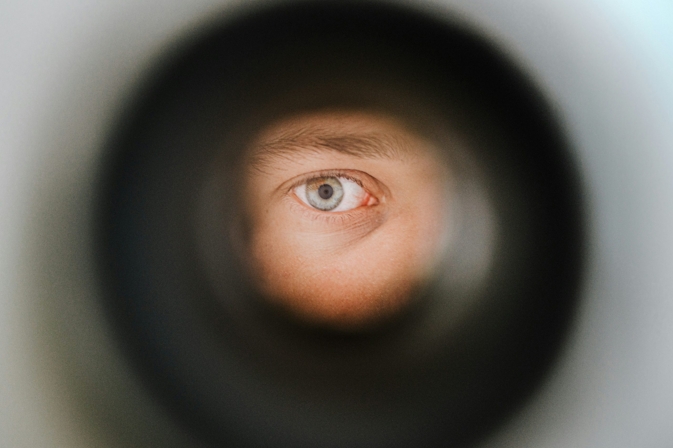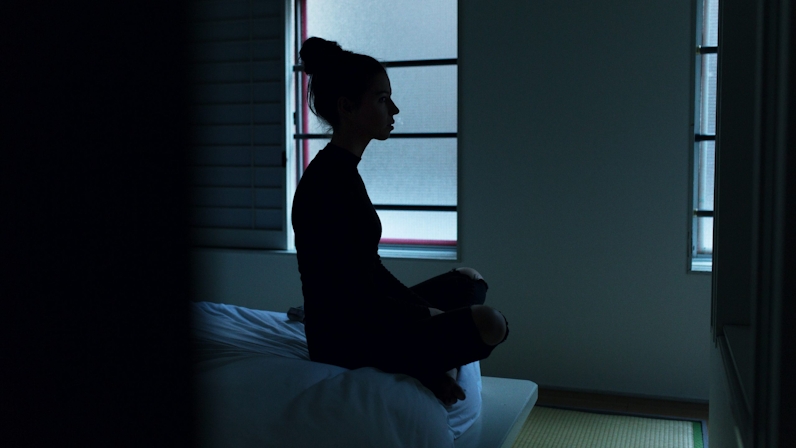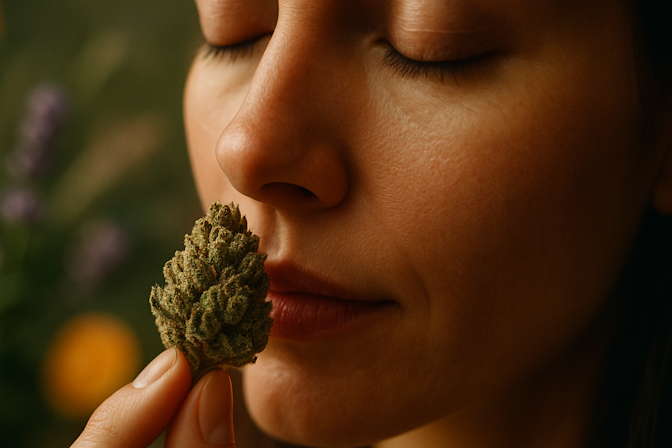
Katie Barrett / Unsplash
Why You Get Paranoid From the Weed: A Deep Dive Into Strains, Terpenes, and Brain Chemistry
The paranoia isn’t random; THC content, terpenes, or your own personal tolerance to cannabis can be driving factors.
Cannabis affects people in all kinds of ways. For some, smoking weed brings a sense of calm or a boost in energy and focus. For others, it can trigger a wave of unease, paranoia, second-guessing, and a body that suddenly feels too aware of itself. If you’ve found yourself there, it doesn’t mean you’re doing it wrong. There are reasons why this happens, and they go deeper than THC alone.
From interactions within the brain to outside stressors, this guide breaks down what actually causes cannabis-related paranoia and how you can lower the chance of winding up in that headspace again.
Why Paranoia Happens

Mario Heller / Unsplash
The endocannabinoid system also plays an important role here. It regulates how the brain responds to stress and helps maintain emotional balance. Getting paranoid from the weed often starts in the amygdala, the part of the brain that responds to fear, threat, and emotional processing. THC mimics compounds your body already produces and interacts with cannabinoid receptors throughout the brain, including this region.
These interactions may amplify emotional reactivity in ways that aren’t always pleasant. For some, the interaction creates a euphoric experience. For others, it intensifies anxiety and crowds the mind with paranoid thoughts. Depending on the dose, environment, or your baseline stress levels, this shift in brain signaling can feel overwhelming, especially when reward centers and fear-processing areas are activated simultaneously.
It’s not always about your mindset, either. Genetics, mental health history, and cannabis sensitivity can all influence how you respond. Some people feel calm under the same conditions that make others hypervigilant or uneasy. The symptoms are real, and they’re linked to how cannabis changes brain activity in key regions that affect mood, perception, and self-awareness.
More Than THC to Blame

Herb
THC content matters, but paranoia doesn’t always show up with this psychoactive compound. Some people feel fine at 25%, while others get anxious at 10%. That’s often tied to what else is in the product, especially how it’s balanced with other cannabinoids and cannabis terpenes.
When CBD or other minor cannabinoids are lacking in a strain, the effects of THC may feel stronger and less predictable. Certain terpenes, especially those associated with energy or mental stimulation, may intensify the effects of a strain. Together, compounds like cannabinoids and terpenes may shape the overall experience, and not everyone responds in the same way.
Individual cannabis tolerance also plays a role, but so do hormones, stress levels, and even how rested you are. A strain that felt fine last week might hit differently today, depending on what your body and brain are carrying into the session. The method of consumption also affects things; how quickly it hits and how long it lasts can either smooth out the situation or exacerbate it.
What’s in the strain and how it interacts with everything else going on can make all the difference.
Cannabinoid Ratios and Terpenes
Every strain hits a little differently. But when the THC content is high, other cannabinoids are low, and the terpene profile leans stimulating, the experience may be likely to make you feel on edge, especially for people prone to anxiety or with lower tolerance. Some combinations don’t sit well, even if the THC percentage isn’t that high.
Certain terpenes present in strains are mentioned in conversations and certain research as being more anxiety-inducing than others. They may not cause it directly, but they may shift your mental state enough to make everything feel a little off:
- Terpinolene – Common in hazy, Sativa-leaning strains. It brings energy but may also feel chaotic or disjointed.
- Pinene – May be focused and clearheaded in small amounts, but heavy doses of pinene may ramp things up.
- Limonene – Often described as uplifting, but it may spike anxious energy if your baseline’s already shaky.
- Guaiol – Less researched, but some people say it leaves them mentally foggy or on edge.
Even if THC levels are similar, the way cannabinoids interact may change how a strain feels. If you’re someone who’s felt paranoid on weed, it’s worth paying attention to the whole profile, not just the THC percentage.
- High THC – More likely to cause feelings of paranoia, especially in new users.
- High THC + Low CBD – Common in many modern strains; often linked to cannabis-related paranoia.
- Low THC + Low CBD – Typically milder, but may still cause adverse effects and cause paranoia in sensitive individuals.
- Low THC + High CBD – This combo may help minimize potential risks for those prone to paranoia.
- Balanced THC:CBD ratios – Often used to counteract the psychoactive effects of THC, reduce negative feelings, and promote calmness.
These patterns don’t hold true for everyone, but they show how different combinations might influence the experience in one way or another.
Dosage and Tolerance
People with a low tolerance are generally more prone to feeling paranoid, especially when consuming high-THC products. Even a small amount can feel overwhelming if your system isn’t used to it. That risk goes up with edibles, dabs, or potent flower, anything that hits harder or lasts longer than expected.
Over time, regular cannabis use can shift how your endocannabinoid system responds. If you’ve built up a tolerance and suddenly take a much higher dose or switch product types, you might still feel off, but in a different way: dull, anxious, or physically wired.
Lower doses tend to feel more manageable for most people. Pacing yourself helps avoid both physical symptoms (like a racing heart or tight chest) and the mental spiral that can come with taking too much too fast.
For tips on maintaining balance, check out our guide to strains that can help keep tolerance low.

Ben blennerhassett / Unsplash
Sex Differences
THC doesn’t affect everyone the same way, and sex hormones may be part of the reason. Some research suggests that women experience more potent effects than men, especially during phases of the cycle when estrogen is higher. Estrogen appears to increase sensitivity to THC, which may raise the risk of anxiety or paranoia.
One review notes that THC sensitivity may peak during ovulation for women, and the body’s natural level of anandamide fluctuates with the female cycle. More recent clinical trials have shown that women report more intense intoxication and greater physiological and psychological effects at the same doses as men. These differences don’t apply to everyone, but they may help explain why some people are more vulnerable to the cognitive effects of cannabis, even at lower doses.
While researchers have attempted to identify contributing factors like hormone levels and brain chemistry for individuals experiencing paranoia, more studies are needed.
Set and Setting
Where and how you consume cannabis can shape the entire experience. Loud environments, unfamiliar settings, or being around people you don’t fully trust can all contribute to feelings of unease. That tension gets amplified when THC’s psychoactive effects are in the mix, especially if you’re already anxious or overstimulated going in.
The mindset you bring matters just as much. If you’re stressed, tired, or dealing with mental health issues, cannabis might hit harder than expected. A quiet, familiar space with a calm atmosphere can make a big difference if you’re prone to paranoid thoughts or feeling disconnected during a high.
Consumption Method
The way you consume cannabis plays a significant role in how strong a product feels and how long it lasts. Smoking and vaping tend to produce faster, more controllable effects, while edibles come on slower and can hit harder. The difference comes down to how your body processes THC.
When you eat cannabis, your liver converts the THC in edibles into 11-hydroxy-THC, a compound that produces stronger and longer-lasting effects. That change in potency can catch people off guard, especially those who are sensitive to THC or newer to edibles.
Concentrates like dabs can also be overwhelming due to their high THC levels and quick onset. If your tolerance is low or your dose is too large, the high can feel more intense than expected and more likely to bring on paranoid weed experiences. Cannabis consumption method matters, and it’s important to choose which method suits your preference and tolerance.
Avoid These Cannabis Strains That Make You Paranoid

Herb
Some cannabis strains that induce paranoia come up more often than others among consumers for their intense effects or overstimulating terpene profiles. Not everyone will react the same, but these strains are frequently flagged in discussions around paranoid weed experiences:
- Green Crack – High THC and terpinolene levels; many report mental racing and feelings of paranoia.
- Jack Herer – Energizing but rich in terpinolene and pinene; may worsen anxiety in some.
- Durban Poison – A classic landrace Sativa that can feel mentally intense and jittery, according to some.
- Sour Diesel – Pungent and powerful; its sharp effects may tip into overstimulation in some cases.
- Strawberry Cough – Socially uplifting for some, overstimulating for others due to its complex terpene profile.
Strains that make you paranoid often share two traits: high THC content and energetic Sativa-dominant genetics with specific terpenes.
FAQs

What are weed paranoia symptoms?
Racing heart, nervousness, dry mouth, tight chest, and irrational suspicion or paranoid thoughts are common symptoms.
How long does weed paranoia last?
It usually peaks within 30 to 60 minutes and fades after 2 to 4 hours, depending on dosage and consumption method.
Which terpenes cause paranoia?
Terpinolene, pinene, guaiol, and limonene are the most commonly present terpenes in strains that consumers say cause paranoia. These terpenes may feel overstimulating, especially in high-THC strains or when your tolerance is low. They may not cause paranoia on their own, but in certain combinations or moods, they can lead to an experience in that direction.
Does indica or sativa make you more paranoid?
People often report that sativa strains make them more paranoid, likely due to terpene profiles and mentally stimulating effects.
Why does weed make me paranoid after years of smoking?
You might be consuming too much THC, using different strains, or reacting to changes in tolerance, life stress, or mental health.
What can you do if you are experiencing paranoia from marijuana use?
If you are experiencing negative effects like paranoia, try some deep breathing exercises. If you are feeling worse or still experiencing behavioral symptoms associated with mental health conditions, it is recommended to seek professional support.
Herb Recommended Products:
READ MORE










